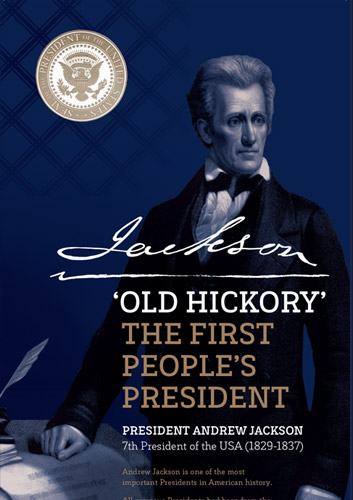President Andrew Jackson – 7th President of the USA (1829–1837)
‘Old Hickory’ The First People’s President
A true ‘Son of Ulster’ who shaped the world’s greatest democracy
Andrew Jackson is one of the most important presidents in American history.
All previous presidents had been from the upper class of American society – he was the first ordinary citizen to be elected to the highest office. ‘Jacksonian Democracy’ is still regarded as one of the most distinctive features of American political life. His family roots are in the ‘Scotch Quarter’ end of Carrickfergus at Boneybefore and at nearby Bellahill.
Andrew Jackson is one of the most important presidents in American history.
All previous presidents had been from the upper class of American society – he was the first ordinary citizen to be elected to the highest office. ‘Jacksonian Democracy’ is still regarded as one of the most distinctive features of American political life. His family roots are in the ‘Scotch Quarter’ end of Carrickfergus at Boneybefore and at nearby Bellahill.
Ireland: An Island of Cultural Variety
FOR THOUSANDS OF YEARS people have travelled across the narrow sea between Ulster and Scotland. From the early 1600s onwards, Lowland Scots came to Ulster in their thousands seeking prosperity and religious freedom and formed a settled community across nine counties and beyond. Their descendants and the hundreds of thousands who came after them are known as Ulster-Scots.
Names for a People
Many of us have been deprived of our own history and these terms can sometimes seem new. The term ‘Ulster Scots’ first appeared in writing in 1640. When Ulster-Scots emigrated to America they described themselves, and were described by others, as ‘Scotch-Irish’ as early as the 1680s. Rev Francis Makemie from Donegal described himself as ‘Scoto-Hybernicus’. He emigrated to Somerset County in Maryland to minister to an Ulster emigrant community, where the court records of that time described them as ‘Scotch-Irish’. A variation – ‘Scots Irish’ is a much later term, popularised in the late 20th century.
Many of us have been deprived of our own history and these terms can sometimes seem new. The term ‘Ulster Scots’ first appeared in writing in 1640. When Ulster-Scots emigrated to America they described themselves, and were described by others, as ‘Scotch-Irish’ as early as the 1680s. Rev Francis Makemie from Donegal described himself as ‘Scoto-Hybernicus’. He emigrated to Somerset County in Maryland to minister to an Ulster emigrant community, where the court records of that time described them as ‘Scotch-Irish’. A variation – ‘Scots Irish’ is a much later term, popularised in the late 20th century.
Emigration
During the 1600s the Ulster-Scots and their Lowland Scottish kinfolk experienced decades of state persecution, which culminated in the brutal Siege of Derry where 8000 were starved to death by the armies of King James II. The horrors were only relieved by the famous ‘Glorious Revolution’ led by the new King William of Orange in 1688–90, but this brought only a brief respite. When William died in 1702 the persecutions resumed.
The members of the corporation of Londonderry resigned their posts in protest at the new oppressive laws. Many veterans of the Siege were among the first to board ships bound for America. In 1718 the first organised migrations commenced, a trickle which became a river. Eventually an estimated 250,000 Ulster-Scots would leave the oppressions of their homeland for the promise of the New World.
During the 1600s the Ulster-Scots and their Lowland Scottish kinfolk experienced decades of state persecution, which culminated in the brutal Siege of Derry where 8000 were starved to death by the armies of King James II. The horrors were only relieved by the famous ‘Glorious Revolution’ led by the new King William of Orange in 1688–90, but this brought only a brief respite. When William died in 1702 the persecutions resumed.
The members of the corporation of Londonderry resigned their posts in protest at the new oppressive laws. Many veterans of the Siege were among the first to board ships bound for America. In 1718 the first organised migrations commenced, a trickle which became a river. Eventually an estimated 250,000 Ulster-Scots would leave the oppressions of their homeland for the promise of the New World.
From Hardship to Achievers
The Scotch-Irish hurricane made landfall in North America, and they would soon shape the future of the continent. Their love of civil and religious liberty, personal freedom, of liberty before loyalty, would secure American Independence in 1776. During the battles of the American Revolution, Scotch-Irish Presbyterian ministers would stir their congregations with tales of what their forefathers had done at Derry and Enniskillen and were the first to commit to take up arms against the Crown should their liberties be threatened.
The inevitable happened and Independence had to be fought for and was won. British Crown rule in America was replaced by a democratic government, but which was led by a new élite. However down in the remote frontier Waxhaws of the Carolinas, a true ‘son of Ulster’ had been forged, who would rise to lead the new nation.
The Scotch-Irish hurricane made landfall in North America, and they would soon shape the future of the continent. Their love of civil and religious liberty, personal freedom, of liberty before loyalty, would secure American Independence in 1776. During the battles of the American Revolution, Scotch-Irish Presbyterian ministers would stir their congregations with tales of what their forefathers had done at Derry and Enniskillen and were the first to commit to take up arms against the Crown should their liberties be threatened.
The inevitable happened and Independence had to be fought for and was won. British Crown rule in America was replaced by a democratic government, but which was led by a new élite. However down in the remote frontier Waxhaws of the Carolinas, a true ‘son of Ulster’ had been forged, who would rise to lead the new nation.
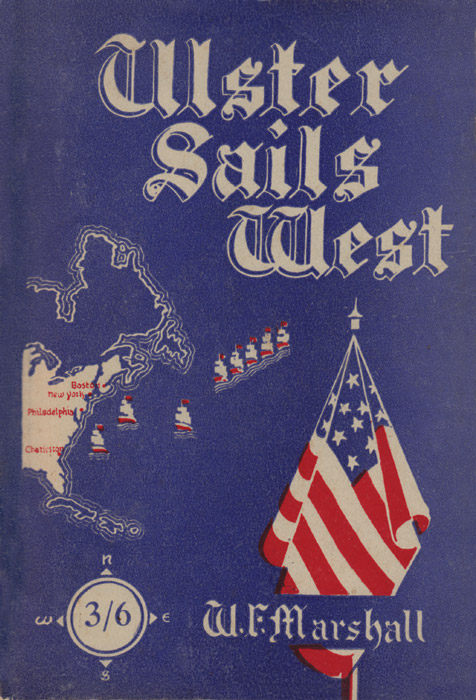
This 1940s publication celebrated Ulster’s links with America at the time when thousands of GIs were stationed in Northern Ireland
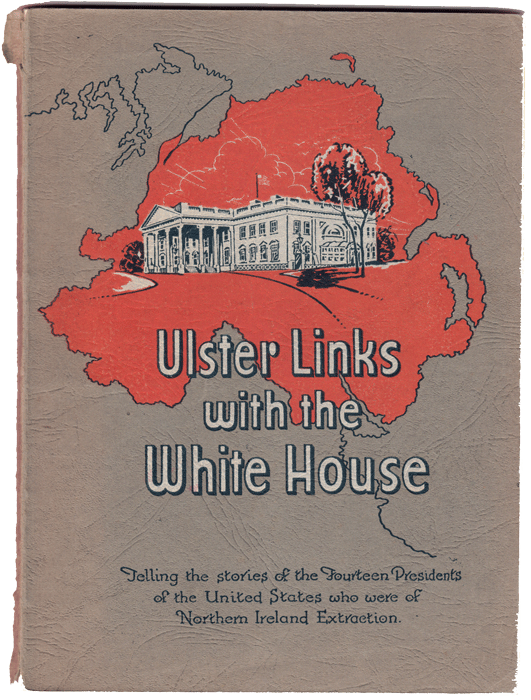
Ulster Links with the White House (1942). The authors are believed to have been Rev. W.F. Marshall and Sam Henry. The 14 President biographies included pencil portraits by renowned Belfast artist Frank McKelvey.
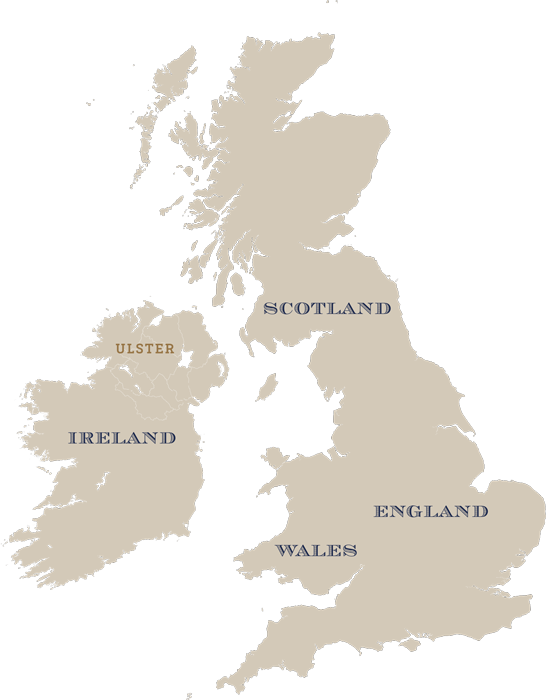
At the narrowest part, only 13 miles separate Ulster – Ireland’s northern province – and Scotland. The sea has been a bridge rather than a barrier. Almost 2 million people make the crossing by ferry every year.
Jackson’s Ulster-Scots Roots
THE JACKSON FAMILY lived in the strongly Ulster-Scots district of south east Antrim for many generations. Their ancestors were among the thousands who migrated from Lowland Scotland to Ulster in the 1600s. The first Jacksons are said to have arrived in 1639. Their first homestead was at Bellahill, between Carrickfergus and Ballycarry, and from which Scotland can easily be seen on a clear day.
Early Carrickfergus and Ballycarry
Carrickfergus took its name from Fergus, the first King of Scotland, who drowned when his ship was wrecked on a rock or ‘carraig’ in AD501. The Anglo-Norman castle was built in 1177 – it and the small town had been taken over by the Scottish Bruces in the early 1300s; they used it as their headquarters during their failed attempt to take control of all of Ireland. The English walled town was surrounded by Scottish people from the early 1600s, many of whom settled just outside the walls at ‘Scotch Quarter’. At nearby Kilroot and Ballycarry came Ireland’s first Presbyterian minister, Rev Edward Brice, who arrived in 1613. Undoubtedly this was a Scots-speaking community.
Carrickfergus took its name from Fergus, the first King of Scotland, who drowned when his ship was wrecked on a rock or ‘carraig’ in AD501. The Anglo-Norman castle was built in 1177 – it and the small town had been taken over by the Scottish Bruces in the early 1300s; they used it as their headquarters during their failed attempt to take control of all of Ireland. The English walled town was surrounded by Scottish people from the early 1600s, many of whom settled just outside the walls at ‘Scotch Quarter’. At nearby Kilroot and Ballycarry came Ireland’s first Presbyterian minister, Rev Edward Brice, who arrived in 1613. Undoubtedly this was a Scots-speaking community.
Jackson Ancestors
The future President’s great grandfather, John Jackson, was born in Carrickfergus in 1667, and held a number of prominent positions in the town. John and Peter Jackson were made ‘freemen’ of Carrickfergus in 1683, just seven years before King William of Orange landed at the town in 1690. John Jackson was one of those who signed a document of ‘Presbyterian Loyalty’ in Carrickfergus in 1708.
Andrew’s grandfather, Hugh Jackson, was a linen weaver. He passed down his memories of the short-lived French invasion of 1760. Commanded by Francois Thurot, the French arrived at Kilroot and marched on Carrickfergus through the hamlet of Boneybefore. When Hugh’s son Andrew (Senior) married Elizabeth Hutchinson, they settled into a cottage home at Boneybefore, where their sons Hugh and Robert were born.
The future President’s great grandfather, John Jackson, was born in Carrickfergus in 1667, and held a number of prominent positions in the town. John and Peter Jackson were made ‘freemen’ of Carrickfergus in 1683, just seven years before King William of Orange landed at the town in 1690. John Jackson was one of those who signed a document of ‘Presbyterian Loyalty’ in Carrickfergus in 1708.
Andrew’s grandfather, Hugh Jackson, was a linen weaver. He passed down his memories of the short-lived French invasion of 1760. Commanded by Francois Thurot, the French arrived at Kilroot and marched on Carrickfergus through the hamlet of Boneybefore. When Hugh’s son Andrew (Senior) married Elizabeth Hutchinson, they settled into a cottage home at Boneybefore, where their sons Hugh and Robert were born.
Arthur Dobbs
The local landlord was Arthur Dobbs (1689–1765). He acquired land in the New World and promoted emigration opportunities to his Ulster tenants. Some 75 families made the two month voyage from Antrim to America, “They are a Colony from Ireland removed from Pennsylvania of what we call Scotch-Irish Presbyterians who with others in the neighbouring Tracts had settled”. Dobbs became Governor of North Carolina in 1753.
Andrew’s uncle Hugh Jackson served in America with the 49th Regiment of the British Army in 1756, in Mecklenburg County in North Carolina. The President later recalled that his uncle came back to Ireland in late 1764 and ‘planned to return to raise a colony in the Carolinas’.
‘All the people of this part of the world speak the broad Lowland Scotch and have all the Scotch phrases. It will be a dispute between the two kingdoms until the end of time whether Ireland was peopled from Scotland or Scotland from Ireland’.
Lord Edward Willes’ description of East Antrim, 1760
The local landlord was Arthur Dobbs (1689–1765). He acquired land in the New World and promoted emigration opportunities to his Ulster tenants. Some 75 families made the two month voyage from Antrim to America, “They are a Colony from Ireland removed from Pennsylvania of what we call Scotch-Irish Presbyterians who with others in the neighbouring Tracts had settled”. Dobbs became Governor of North Carolina in 1753.
Andrew’s uncle Hugh Jackson served in America with the 49th Regiment of the British Army in 1756, in Mecklenburg County in North Carolina. The President later recalled that his uncle came back to Ireland in late 1764 and ‘planned to return to raise a colony in the Carolinas’.
‘All the people of this part of the world speak the broad Lowland Scotch and have all the Scotch phrases. It will be a dispute between the two kingdoms until the end of time whether Ireland was peopled from Scotland or Scotland from Ireland’.
Lord Edward Willes’ description of East Antrim, 1760
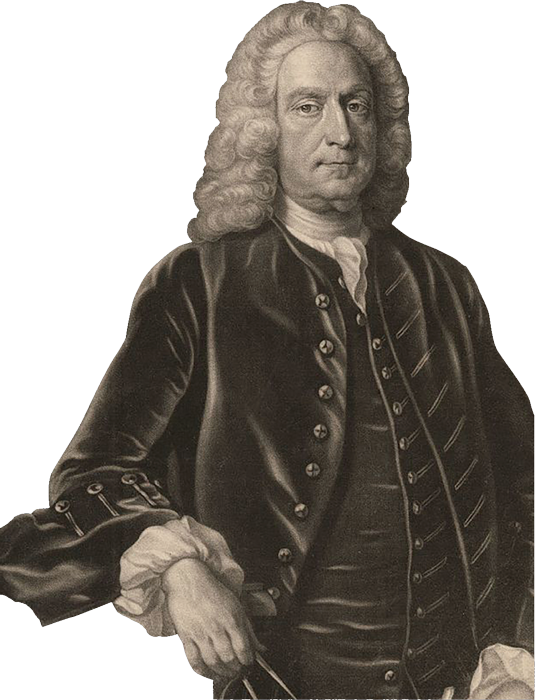
Arthur Dobbs, Carrickfergus landowner and later the Governor of North Carolina
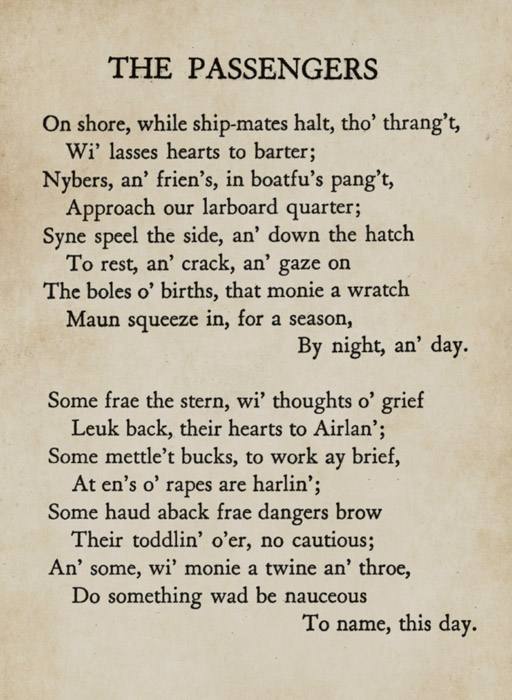
James Orr’s poem ‘The Passengers’ is an account of emigration from Antrim to America, in Ulster-Scots. He was from Ballycarry and would have known the wider Jackson family.
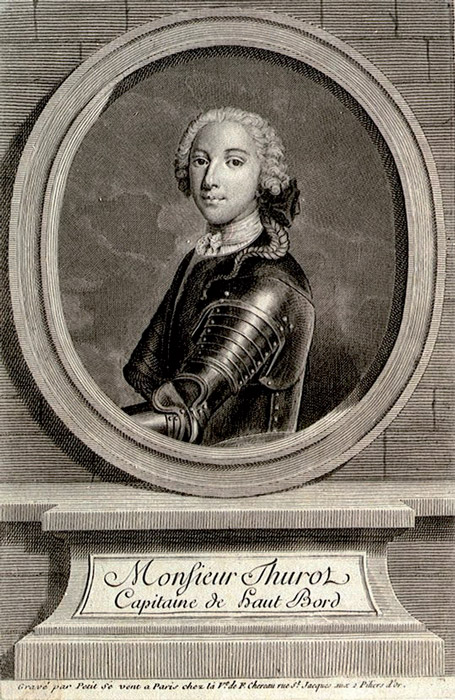
Francois Thurot, who led the French invasion of Carrickfergus in 1760

Scottish settlers came to the Carrickfergus area in large numbers from the early 1600s. They settled outside the walls of the English-dominated town, as shown by the name ‘Scotch Quarter’, and in the surrounding countryside.
Birth of An American Icon
ANDREW (SENIOR) AND ELIZABETH, and their sons Hugh and Robert, sailed from Larne in late 1765 or early 1766. They arrived at Charleston, where a little-known Ulster-Scots settlement led by a Thomas Ferguson had been established in 1683. They migrated to the Scotch-Irish community of the Waxhaws region of the Carolinas. A Presbyterian church had been established there in 1752. It was on 15 March 1767 that the future president was born.
Waxhaw Home
Edmund Burke in his work An account of the European settlements in America (1757), commented that the settlers in the frontier parts of Virginia, Maryland and North Carolina were ‘chiefly Presbyterians from the Northern part of Ireland, who in America are generally called Scotch Irish.’
The family acquired a 200 acre tract of poor land at ‘Twelve Mile Creek’, close to today’s city of Charlotte. But less than two years later, Andrew Snr died aged just 29, and only days before their third son was born. His gravestone can be seen today at Waxhaw Presbyterian Churchyard. Widowed Elizabeth took her young family to live with another Ulster family, the Crawfords, one of whom was her sister Jane.
Edmund Burke in his work An account of the European settlements in America (1757), commented that the settlers in the frontier parts of Virginia, Maryland and North Carolina were ‘chiefly Presbyterians from the Northern part of Ireland, who in America are generally called Scotch Irish.’
The family acquired a 200 acre tract of poor land at ‘Twelve Mile Creek’, close to today’s city of Charlotte. But less than two years later, Andrew Snr died aged just 29, and only days before their third son was born. His gravestone can be seen today at Waxhaw Presbyterian Churchyard. Widowed Elizabeth took her young family to live with another Ulster family, the Crawfords, one of whom was her sister Jane.
A Mother’s Influence
Andrew later recalled his mother’s tales of how hard life had been in Ulster, of how Ulster-Scots Presbyterians had suffered ‘oppression by the nobility of Ireland over the labouring poor’.. She advised him to “Make friends by being honest, keep them by being steadfast; Andy, never tell a lie, nor take what is not your own, nor sue for slander, settle these cases yourself”.
Elizabeth’s careful parenting, combined with the cultural inheritance that the Ulster-Scots community had brought with them to the Waxhaws, would forge the boy into a man.
Andrew later recalled his mother’s tales of how hard life had been in Ulster, of how Ulster-Scots Presbyterians had suffered ‘oppression by the nobility of Ireland over the labouring poor’.. She advised him to “Make friends by being honest, keep them by being steadfast; Andy, never tell a lie, nor take what is not your own, nor sue for slander, settle these cases yourself”.
Elizabeth’s careful parenting, combined with the cultural inheritance that the Ulster-Scots community had brought with them to the Waxhaws, would forge the boy into a man.
Birthplace Debate?
There have been occasional stories that Andrew Jackson was in fact Ulster-born, but no firm evidence has ever been found to substantiate this claim. In Samuel Miskimmin’s History and Antiquities of Carrickfergus (1909 edition) is a suggestion that a baby called Andrew had been born at sea, but had died during the voyage, and that the next son was given his name. Jackson’s American biographers dismiss these claims. Andrew Jackson himself was always vague about where he was born. He could not, of course, have raised any doubts himself about his birth in America, as that would have made him ineligible for the Presidency. A political opponent, Donegal-born Alexander Porter, spent time in Ireland attempting to prove the rumours, but was unsuccessful.
“The family from which General Andrew Jackson is descended were ... among the emigrants from Scotland to the province of Ulster. They were strict adherents to the Church of Scotland, and transmitted their religion, as well as their dialect, to their descendants of the present age.”
From Life of Andrew Jackson, by Amos Kendall, 1843. Kendall was one of Jackson’s ‘Kitchen Cabinet’.
There have been occasional stories that Andrew Jackson was in fact Ulster-born, but no firm evidence has ever been found to substantiate this claim. In Samuel Miskimmin’s History and Antiquities of Carrickfergus (1909 edition) is a suggestion that a baby called Andrew had been born at sea, but had died during the voyage, and that the next son was given his name. Jackson’s American biographers dismiss these claims. Andrew Jackson himself was always vague about where he was born. He could not, of course, have raised any doubts himself about his birth in America, as that would have made him ineligible for the Presidency. A political opponent, Donegal-born Alexander Porter, spent time in Ireland attempting to prove the rumours, but was unsuccessful.
“The family from which General Andrew Jackson is descended were ... among the emigrants from Scotland to the province of Ulster. They were strict adherents to the Church of Scotland, and transmitted their religion, as well as their dialect, to their descendants of the present age.”
From Life of Andrew Jackson, by Amos Kendall, 1843. Kendall was one of Jackson’s ‘Kitchen Cabinet’.
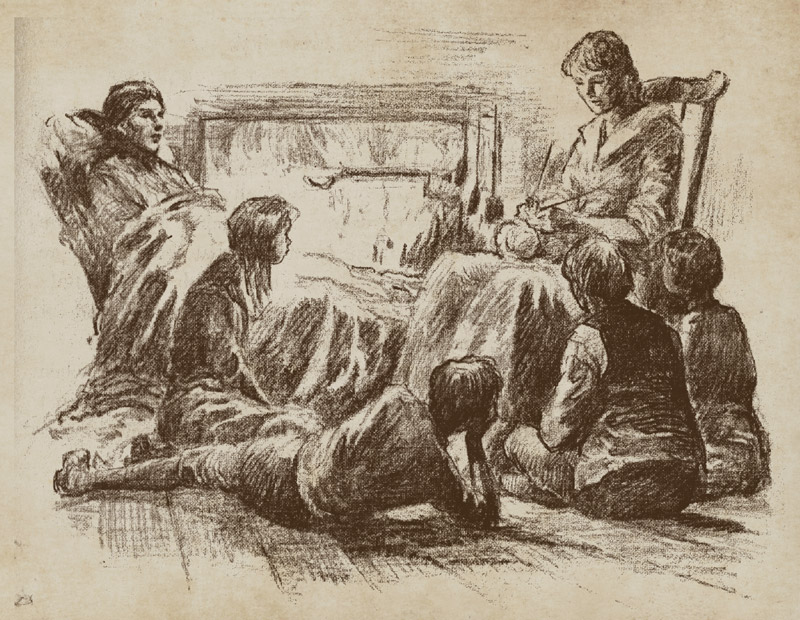
Elizabeth Jackson telling stories of life back in Ulster to her three sons, her sister Jane Crawford and one of Jane’s daughters. From Andrew Jackson - Frontier Statesman, (Illinois, 1954). Illustration by Lorence F. Bjorklund (1911 - 1978).

Marker stone at Waxhaw Presbyterian Church, ‘organized 1755 by Scotch-Irish’.

The Waxhaws childhood log cabin home of Andrew Jackson
Andrew Jackson’s Early Years
ANDREW JACKSON GREW UP in a community simmering with revolution. The ‘Sons of Liberty’ movement in Jackson’s North Carolina were known as ‘Regulators’, who in May 1771 took part in the Battle of Alamance. Presbyterian minister Rev David Caldwell told them that “our forefathers, or many of them, sacrificed at Londonderry and Enniskillen their lives, that they might hand down to us the fair inheritance of liberty.”
A Family in Battle
In 1776, when Andrew Jackson was only 9 years old, he was asked to read aloud the American Declaration of Independence to the people of the Waxhaws. The war that followed would last for eight long years and the Waxhaws became known to the British as “the hornet’s nest”.
His oldest brother Hugh joined the local militia company, but died of heat exhaustion after a battle in 1779. Andrew and brother Robert joined the mounted militia of South Carolina. In 1781 their Presbyterian church was burned by British dragoons. The brothers were captured by the British army and Andrew was slashed by an officer’s sword, having refused to clean his boots. Soon after this Robert died, as did their mother Elizabeth. Andrew Jackson was an orphan at 14. Years later he spoke movingly of his feelings on hearing of her death: ‘I felt utterly alone and tried to recall her last words to me.’
In 1776, when Andrew Jackson was only 9 years old, he was asked to read aloud the American Declaration of Independence to the people of the Waxhaws. The war that followed would last for eight long years and the Waxhaws became known to the British as “the hornet’s nest”.
His oldest brother Hugh joined the local militia company, but died of heat exhaustion after a battle in 1779. Andrew and brother Robert joined the mounted militia of South Carolina. In 1781 their Presbyterian church was burned by British dragoons. The brothers were captured by the British army and Andrew was slashed by an officer’s sword, having refused to clean his boots. Soon after this Robert died, as did their mother Elizabeth. Andrew Jackson was an orphan at 14. Years later he spoke movingly of his feelings on hearing of her death: ‘I felt utterly alone and tried to recall her last words to me.’
Ulster Inheritance and Legal Career
When his grandfather died back in Carrickfergus, Andrew inherited £400, then a substantial amount of money, but he squandered it and the remnant of his father’s farmland on gambling. He returned to education and was tutored by a Scotch-Irishman called Robert McCulloch. His education complete, Jackson persuaded a successful lawyer to allow him to study law, and in 1787 he was admitted to the bar. The following year he was appointed Public Prosecutor of Western District of North Carolina, an area that included today’s Tennessee.
When his grandfather died back in Carrickfergus, Andrew inherited £400, then a substantial amount of money, but he squandered it and the remnant of his father’s farmland on gambling. He returned to education and was tutored by a Scotch-Irishman called Robert McCulloch. His education complete, Jackson persuaded a successful lawyer to allow him to study law, and in 1787 he was admitted to the bar. The following year he was appointed Public Prosecutor of Western District of North Carolina, an area that included today’s Tennessee.
North Carolina to Nashville
He relocated to Nashville in 1790, a town only ten years old. He formed a legal practice with fellow lawyer John Overton, and became a close colleague of William Blount who was a powerful and well-connected friend of the Donelsons. Jackson became Attorney General of Tennessee and when it formally became a state, he was elected as its only US Representative, and later as a Senator. However he resigned this post 1798, and became a judge of the Tennessee Supreme Court until 1804.
“Scotch-Irish Presbyterians, who formed so large a proportion of the people of North Carolina, and moulded its religious and political character… their ideas of religious liberty have given a colouring to their political notions on all subjects”
Rev Benjamin Morris, Christian Life and Character Of The Civil Institutions Of The United States (1864)
He relocated to Nashville in 1790, a town only ten years old. He formed a legal practice with fellow lawyer John Overton, and became a close colleague of William Blount who was a powerful and well-connected friend of the Donelsons. Jackson became Attorney General of Tennessee and when it formally became a state, he was elected as its only US Representative, and later as a Senator. However he resigned this post 1798, and became a judge of the Tennessee Supreme Court until 1804.
“Scotch-Irish Presbyterians, who formed so large a proportion of the people of North Carolina, and moulded its religious and political character… their ideas of religious liberty have given a colouring to their political notions on all subjects”
Rev Benjamin Morris, Christian Life and Character Of The Civil Institutions Of The United States (1864)
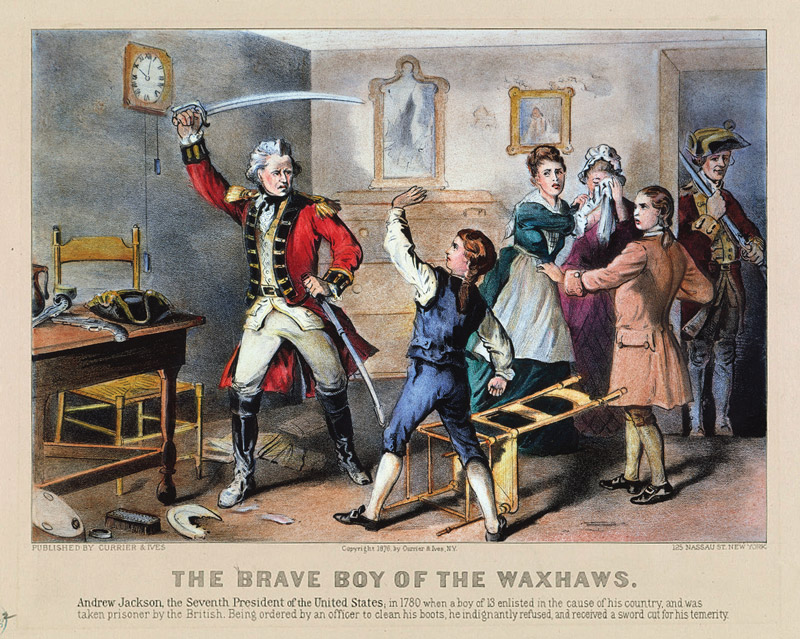
‘The Brave Boy of the Waxhaws’ - a depiction of Jackson’s formative experience of refusing to clean the boots of a British army officer. Discover

The Mecklenburg Declaration from North Carolina in 1775 was a Scotch-Irish proclamation of liberty.
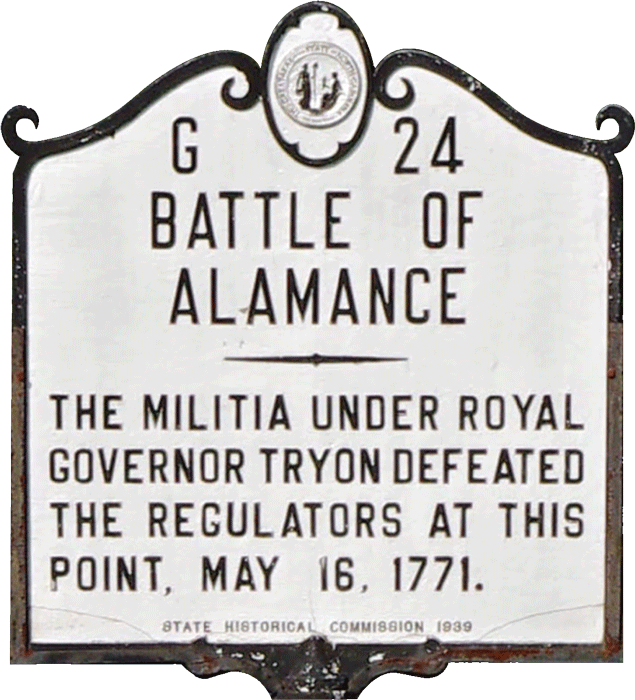
“... The first battle fought for, the first blood shed in, the cause of American freedom was not at Lexington but at Alamance by the Scotch-Irish... ” – D.C. Rankin, Proceedings of the Scotch-Irish Society (1890)
Marriage and Family
ANDREW JACKSON MET RACHEL DONELSON in Nashville in 1791 and they married a year later. She was also of Scotch-Irish Presbyterian lineage. Her father, John Donelson, moved to America from Carnmoney in County Antrim, which was just over ten miles away from the Jacksons’ Ulster homeplace outside Carrickfergus. In 1804 the Jacksons bought a plantation near Nashville which became known as The Hermitage. This was to be their home.
Rachel’s Pioneer Journey to Nashville
Like the Jacksons, the Donelsons had left Ulster for east Virginia in the mid 1700s. Rachel was born in Pittsylvania County in the middle of the state; her father was a landowner and surveyor. In 1777 Rachel’s father John, another Ulsterman called James Robertson, and a lawyer called Richard Henderson, planned an exploratory expedition to strike westwards into unsettled Tennessee. Robertson took two years to scout the landscape and scope the intended migration.
Just before Christmas 1779 two groups started the four month journey – Robertson led a group of 200 by a land route, and Donelson was among a group of 400 who took a river route. They suffered Indian attacks, a smallpox outbreak, hunger, exhaustion, extreme cold, and dangerous river currents and rapids. A number of them were killed or died of illness and drowning. Rachel was only 12 years old and the journey was daunting and perilous. On 24th April 1780 both groups arrived at their destination.
John Donelson kept a diary of the arduous expedition, entitled “Journal of a Voyage, intended by God’s permission, in the good boat Adventure, from Fort Patrick Henry, on Holston river to the French Salt Springs on Cumberland River.”
Like the Jacksons, the Donelsons had left Ulster for east Virginia in the mid 1700s. Rachel was born in Pittsylvania County in the middle of the state; her father was a landowner and surveyor. In 1777 Rachel’s father John, another Ulsterman called James Robertson, and a lawyer called Richard Henderson, planned an exploratory expedition to strike westwards into unsettled Tennessee. Robertson took two years to scout the landscape and scope the intended migration.
Just before Christmas 1779 two groups started the four month journey – Robertson led a group of 200 by a land route, and Donelson was among a group of 400 who took a river route. They suffered Indian attacks, a smallpox outbreak, hunger, exhaustion, extreme cold, and dangerous river currents and rapids. A number of them were killed or died of illness and drowning. Rachel was only 12 years old and the journey was daunting and perilous. On 24th April 1780 both groups arrived at their destination.
John Donelson kept a diary of the arduous expedition, entitled “Journal of a Voyage, intended by God’s permission, in the good boat Adventure, from Fort Patrick Henry, on Holston river to the French Salt Springs on Cumberland River.”
The Founding of Nashville
The settlement they founded was at Fort Nashborough, later Nashville, and soon after they composed their own mini-constitution, the Cumberland Compact, which was signed by 256 colonists. Today a statue of Robertson and Donelson shaking hands can be seen at the Fort Nashborough visitor attraction. As the town developed in the early 1800s, many of its most successful businessmen were from Ulster, such as merchant and banker George Crockett who was from east Donegal. A David Fulton worked with Crockett, and later his brother William Fulton would work with Andrew Jackson.
The settlement they founded was at Fort Nashborough, later Nashville, and soon after they composed their own mini-constitution, the Cumberland Compact, which was signed by 256 colonists. Today a statue of Robertson and Donelson shaking hands can be seen at the Fort Nashborough visitor attraction. As the town developed in the early 1800s, many of its most successful businessmen were from Ulster, such as merchant and banker George Crockett who was from east Donegal. A David Fulton worked with Crockett, and later his brother William Fulton would work with Andrew Jackson.
Re-Marriage and Adoptions
Rachel was estranged from her first husband, Captain Lewis Robards. Believing that she and Robards were divorced, Jackson married her in 1791. This turned out to be premature and in January 1794 they remarried. They had no children of their own, but adopted a nephew who they named Andrew Jackson junior, and were guardians for seven other children. They also adopted a Native American boy called Lyncoya, who was raised with Andrew junior.
“Our situation here is truly disagreeable… our provision exhausted, the crews almost worn down with hunger and fatigue… We are now without bread and are compelled to hunt the buffalo to preserve life. Worn out with fatigue, our progress at present is slow...”
John Donelson’s Diary, March 1780
Rachel was estranged from her first husband, Captain Lewis Robards. Believing that she and Robards were divorced, Jackson married her in 1791. This turned out to be premature and in January 1794 they remarried. They had no children of their own, but adopted a nephew who they named Andrew Jackson junior, and were guardians for seven other children. They also adopted a Native American boy called Lyncoya, who was raised with Andrew junior.
“Our situation here is truly disagreeable… our provision exhausted, the crews almost worn down with hunger and fatigue… We are now without bread and are compelled to hunt the buffalo to preserve life. Worn out with fatigue, our progress at present is slow...”
John Donelson’s Diary, March 1780
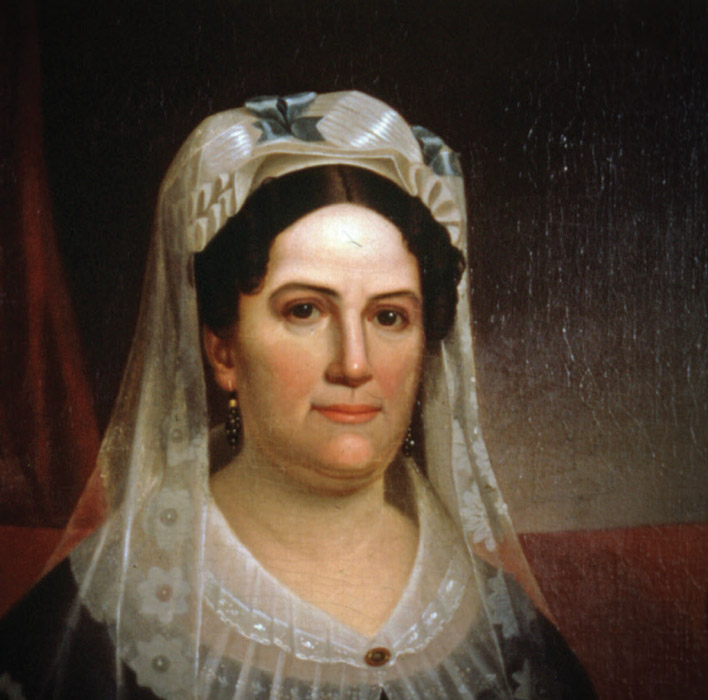
Rachel Donelson

John Donelson’s Diary, 1779. Courtesy Tennessee Virtual Archive.
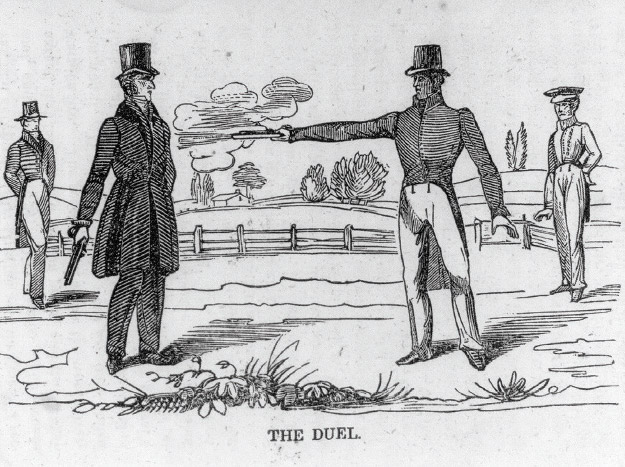
In 1806 Andrew Jackson killed Christopher Dickinson in a duel, for having disrespected Rachel, and for calling Jackson ‘poltroon and a coward’.
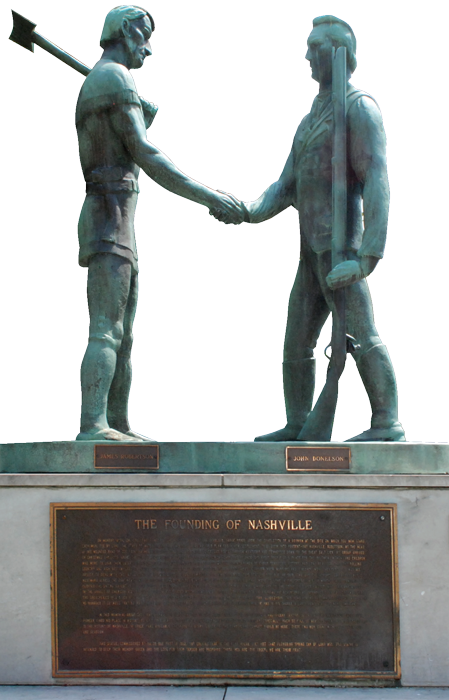
John Donelson and James Roberston monument, Fort Nashborough, Nashville.
Andrew Jackson The Soldier
AGED JUST 35, Andrew Jackson was appointed Major-General of the Tennessee Militia in 1802. For the next 20 years, he was a military man. His first major exploit came in 1812 when he refused to obey orders and marched his men from Mississippi back to Tennessee, earning for himself the title of ‘Old Hickory’. “He’s as tough as Hickory”, his admiring and loyal troops said, and the name stuck.
1812: European And American War
By 1812 James Madison was the President of the young Republic, and the Vice President was George Clinton who, like Jackson, was the son of Presbyterian emigrants from Ireland. In June the United States declared war against Britain, and internally, was at war with various Native American tribes. Washington DC was invaded by the British in 1812; the White House was burned down in August 1814 by a force led by Rostrevor born General Robert Ross. In addition, Britain was supplying Native American tribes with weapons to undermine the new nation.
By 1812 James Madison was the President of the young Republic, and the Vice President was George Clinton who, like Jackson, was the son of Presbyterian emigrants from Ireland. In June the United States declared war against Britain, and internally, was at war with various Native American tribes. Washington DC was invaded by the British in 1812; the White House was burned down in August 1814 by a force led by Rostrevor born General Robert Ross. In addition, Britain was supplying Native American tribes with weapons to undermine the new nation.
1814: Battle of Horseshoe Bend
In what was then Mississippi, but now central Alabama, the United States forces along with Cherokee, Choctaw and ‘Lower Creek’ Indian allies led by Jackson defeated the ‘Upper Creek’ Indians who were in alliance with Britain. British armaments had been supplied through the Spanish-governed Gulf Coast port of Pensacola. The ‘Upper Creek’ encampment was at a bend in the Tallapoosa River. Jackson divided his militias in two formations – he sent one south of the enemy camp, while Jackson led one north. After the victory, at the Treaty of Fort Jackson, the Indians signed over 23 million acres of land to the United States government.
In what was then Mississippi, but now central Alabama, the United States forces along with Cherokee, Choctaw and ‘Lower Creek’ Indian allies led by Jackson defeated the ‘Upper Creek’ Indians who were in alliance with Britain. British armaments had been supplied through the Spanish-governed Gulf Coast port of Pensacola. The ‘Upper Creek’ encampment was at a bend in the Tallapoosa River. Jackson divided his militias in two formations – he sent one south of the enemy camp, while Jackson led one north. After the victory, at the Treaty of Fort Jackson, the Indians signed over 23 million acres of land to the United States government.
1814: Battle of Pensacola and The Treaty Of Ghent
Jackson sent a scout to Pensacola, who confirmed that the British were indeed arming and training Indians there. On 7 November 1814 Jackson successfully led 3000 troops to seize the town. The Spanish quickly surrendered and the British withdrew. A British-American peace treaty was signed at Ghent in Belgium on 24 December, but news of this took weeks to reach the United States.
Jackson sent a scout to Pensacola, who confirmed that the British were indeed arming and training Indians there. On 7 November 1814 Jackson successfully led 3000 troops to seize the town. The Spanish quickly surrendered and the British withdrew. A British-American peace treaty was signed at Ghent in Belgium on 24 December, but news of this took weeks to reach the United States.
1815: Battle of New Orleans
Suspecting a British retaliation 60 miles further along the coast at Mobile, Alabama, Jackson led his forces there but they were urged to rush a further 150 miles to New Orleans. In a famous victory on 8 January 1815, Jackson’s multi-ethnic army of 5000 defeated a British force of 8000. Within 30 minutes, 2000 British were killed or wounded, with Jackson sustaining only 13 losses.
Andrew Jackson was a national hero. He continued in the army until 1821 when he resigned his commission. He and Rachel headed back to The Hermitage in Nashville where he would commence the political campaigning that would lead to the rebuilt White House.
“Greater credit still belongs to Andrew Jackson, who, with his cool head and quick eye, his stout heart and strong hand, stands out in history as the ablest general the United States had produced from the outbreak of the Revolution.”
President Theodore Roosevelt
Suspecting a British retaliation 60 miles further along the coast at Mobile, Alabama, Jackson led his forces there but they were urged to rush a further 150 miles to New Orleans. In a famous victory on 8 January 1815, Jackson’s multi-ethnic army of 5000 defeated a British force of 8000. Within 30 minutes, 2000 British were killed or wounded, with Jackson sustaining only 13 losses.
Andrew Jackson was a national hero. He continued in the army until 1821 when he resigned his commission. He and Rachel headed back to The Hermitage in Nashville where he would commence the political campaigning that would lead to the rebuilt White House.
“Greater credit still belongs to Andrew Jackson, who, with his cool head and quick eye, his stout heart and strong hand, stands out in history as the ablest general the United States had produced from the outbreak of the Revolution.”
President Theodore Roosevelt
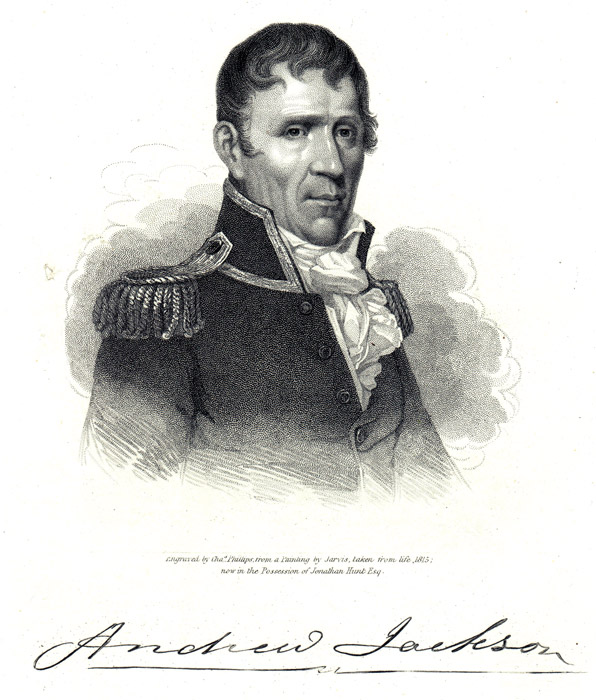
Jackson in his military uniform circa 1810.

The locations of Jackson’s famous victories in 1814 and 1815.
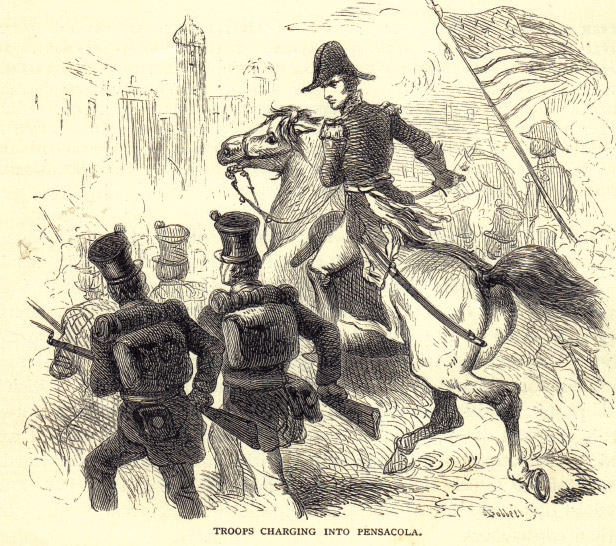
An engraving of Jackson leading the Battle of Pensacola, 1814.
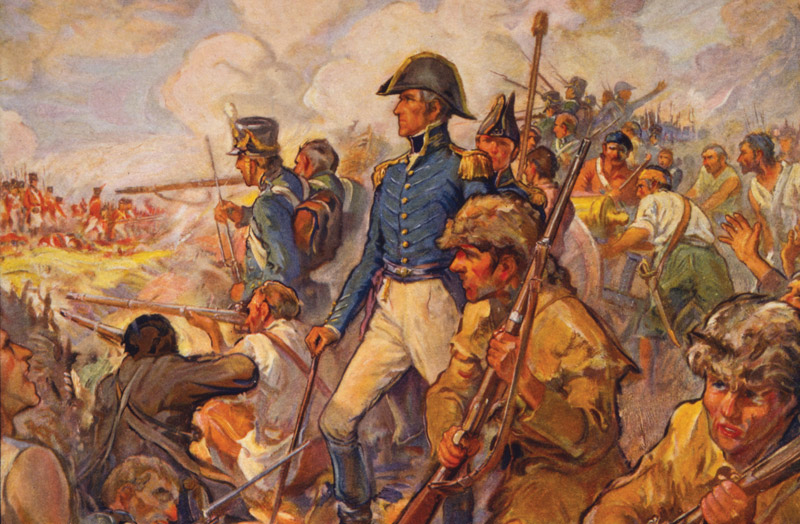
Jackson at the Battle of New Orleans
President Jackson: The First Term
JACKSON’S FIRST PRESIDENTIAL CAMPAIGN in 1824 was unsuccessful. Four candidates ran and Jackson actually won the popular vote, he won the Electoral College, but none of the four had an outright majority. The final decision went to the House of Representatives, who chose John Quincy Adams instead. Jackson and his supporters suspected a ‘corrupt bargain’, and for the duration of Adams’ term, they relentlessly attacked the administration and promoted Jackson as the champion of the common man.
The 1828 Campaign
This animosity set the stage for the next campaign, which was vicious and dirty. Andrew and Rachel Jackson suffered widespread personal smears. But Jackson (standing as a Democrat) was victorious over Adams (who stood as a National Republican), winning with 647,292 votes to Adams’ 507,730, and winning the Electoral College by 178 to 83. Jackson selected Adams’ former Vice-President John C Calhoun to continue in that role. Calhoun’s father Patrick was an Ulster-Scot from County Donegal.
This animosity set the stage for the next campaign, which was vicious and dirty. Andrew and Rachel Jackson suffered widespread personal smears. But Jackson (standing as a Democrat) was victorious over Adams (who stood as a National Republican), winning with 647,292 votes to Adams’ 507,730, and winning the Electoral College by 178 to 83. Jackson selected Adams’ former Vice-President John C Calhoun to continue in that role. Calhoun’s father Patrick was an Ulster-Scot from County Donegal.
A New Era
Tragically, Rachel died before his inauguration. Jackson was the first military leader elected President since George Washington. He had huge popularity among the ordinary people, who came to Washington to celebrate “Old Hickory’s” inauguration. A crowd of 20,000 people walked with the new President along Pennsylvania Avenue to the White House and many of them were allowed into the mansion to wish him well. Such large numbers of people arrived that many of the furnishings were ruined. President Jackson was forced to leave the building by a window to avoid the crush.
Tragically, Rachel died before his inauguration. Jackson was the first military leader elected President since George Washington. He had huge popularity among the ordinary people, who came to Washington to celebrate “Old Hickory’s” inauguration. A crowd of 20,000 people walked with the new President along Pennsylvania Avenue to the White House and many of them were allowed into the mansion to wish him well. Such large numbers of people arrived that many of the furnishings were ruined. President Jackson was forced to leave the building by a window to avoid the crush.
Difficulties
Unfortunately, the first two years of his term were marred by a period of political and social scandal. Polite Washington society shunned the wife of Jackson’s Secretary of War, John Eaton. Meanwhile, several members of his cabinet jockeyed for position to succeed him, so he sacked them all apart from the Postmaster General. A group of trusted allies became his ‘Kitchen Cabinet’.
Unfortunately, the first two years of his term were marred by a period of political and social scandal. Polite Washington society shunned the wife of Jackson’s Secretary of War, John Eaton. Meanwhile, several members of his cabinet jockeyed for position to succeed him, so he sacked them all apart from the Postmaster General. A group of trusted allies became his ‘Kitchen Cabinet’.
Policy
Despite this, he still managed to advance an ambitious programme of political and economic reforms. He replaced public officials he regarded as corrupt, incompetent or openly opposed to his political agenda. He kept government spending under control, stopping a roads bill which Congress had passed because it was too expensive. However, he was involved in the forced removal of Native American tribes from key territories. The Indian Removal Act was passed in 1830, beginning the ‘Trail of Tears’.
He opposed the growing domination of the banks and finance over the people. The charter of the Bank was coming up for renewal and Jackson made it clear that he would only support this if the Bank’s powers were curtailed. His long-term adversary Henry Clay seized the opportunity to attack Jackson, and to then run against him in the next election.
Despite this, he still managed to advance an ambitious programme of political and economic reforms. He replaced public officials he regarded as corrupt, incompetent or openly opposed to his political agenda. He kept government spending under control, stopping a roads bill which Congress had passed because it was too expensive. However, he was involved in the forced removal of Native American tribes from key territories. The Indian Removal Act was passed in 1830, beginning the ‘Trail of Tears’.
He opposed the growing domination of the banks and finance over the people. The charter of the Bank was coming up for renewal and Jackson made it clear that he would only support this if the Bank’s powers were curtailed. His long-term adversary Henry Clay seized the opportunity to attack Jackson, and to then run against him in the next election.
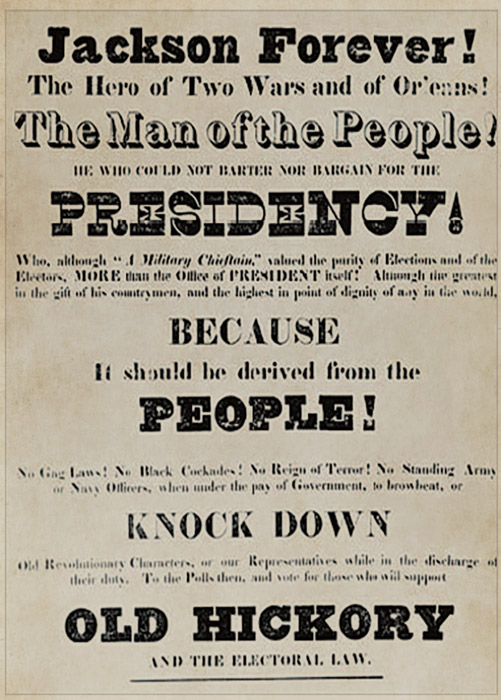
Jackson campaign poster, 1828.
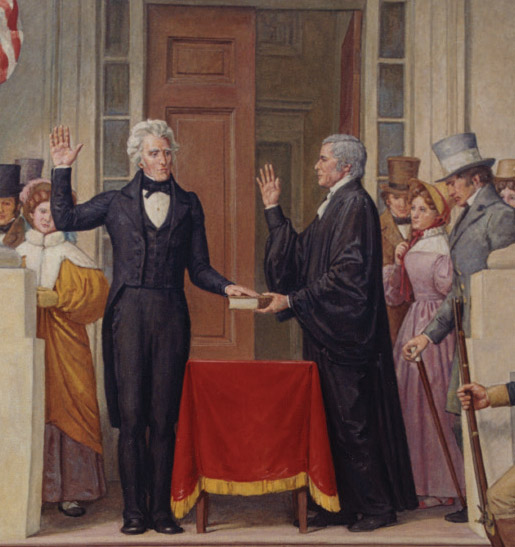
Chief Justice John Marshall administering the oath of office to Andrew Jackson on the east portico of the U.S. Capitol, March 4, 1829. Courtesy Library of Congress.
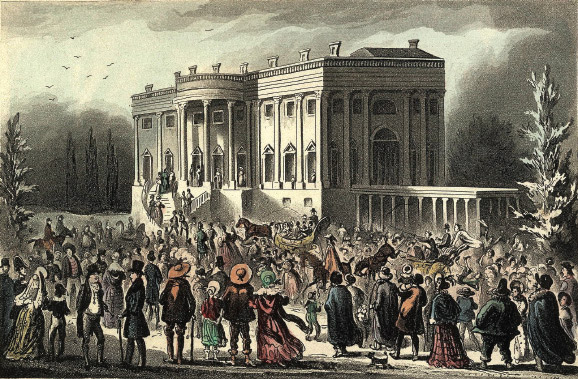
Crowds at Jackson’s entry to the White House, 1829.
“There never was a day like it, before or since, in the history of the White House. Scots-Irish frontiersmen, and a good many who were not, crowded the new presidential mansion. They drank all the liquor, ate all the food, scratched the elegant furniture with their spurs, quarrelled, were sick on the lawn and stole the silver.”
– God’s Frontiersmen by Rory Fitzpatrick (1989)
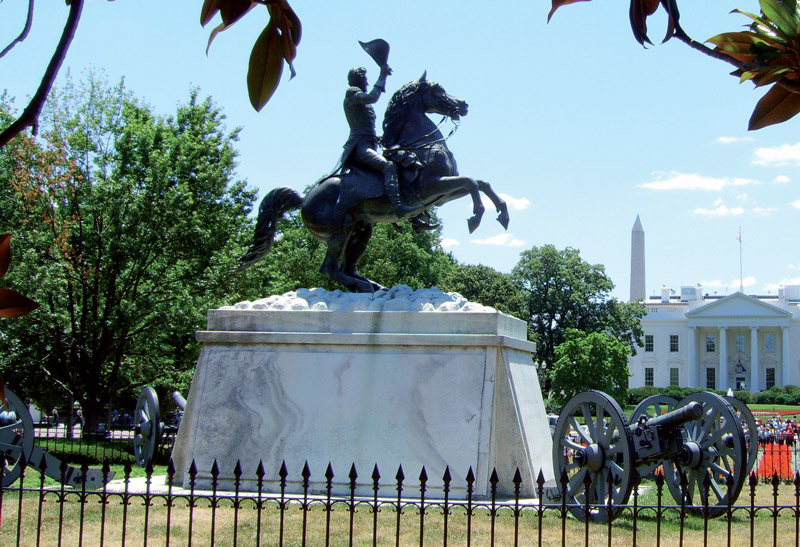
Jackson statue at the White House, Washington DC.
President Jackson: The Second Term
HENRY CLAY CLAIMED that Jackson wanted to broaden the powers of the presidency, and this became a key message in the 1832 presidential campaign. However, Jackson won again, winning 687,502 votes to Clay’s 530,189 votes. Jackson also won the Electoral College, 219 to 49. Flushed with electoral success, Jackson began his second term determined to finish his fight with the Bank, but first he had to fight for the future of the Union itself.
South Carolina
The people of South Carolina, now led by Jackson’s former Vice President John C Calhoun, were aggrieved by federal government policy on trade tariffs. They argued that individual states had the right to reject federal law and, if necessary, secede from the United States. South Carolina nullified the tariff of 1832 and threatened secession. Jackson in turn threatened that federal troops would be sent into the state and his arguments for the preservation of the Union would later be used by Abraham Lincoln during the Civil War era.
The people of South Carolina, now led by Jackson’s former Vice President John C Calhoun, were aggrieved by federal government policy on trade tariffs. They argued that individual states had the right to reject federal law and, if necessary, secede from the United States. South Carolina nullified the tariff of 1832 and threatened secession. Jackson in turn threatened that federal troops would be sent into the state and his arguments for the preservation of the Union would later be used by Abraham Lincoln during the Civil War era.
Breaking the Bank
Having dealt with South Carolina, Jackson returned to the Bank War. He interpreted his massive victory over Clay as a mandate from the people to destroy the bank and replace it with an entirely new system. While forcing his plans through Congress, he sought to weaken the bank through the removal of government deposits. The bank retaliated by calling in loans, which created a panic in the economy. The politicians were divided, with the Senate (controlled by Jackson’s opponents) voting to censure him for removing deposits from the bank, while the House of Representatives voted to support him.
Having dealt with South Carolina, Jackson returned to the Bank War. He interpreted his massive victory over Clay as a mandate from the people to destroy the bank and replace it with an entirely new system. While forcing his plans through Congress, he sought to weaken the bank through the removal of government deposits. The bank retaliated by calling in loans, which created a panic in the economy. The politicians were divided, with the Senate (controlled by Jackson’s opponents) voting to censure him for removing deposits from the bank, while the House of Representatives voted to support him.
Foreign Policy
Jackson’s administration traded with a range of countries, opened new ports to American goods and secured the repayment of huge debts owed to the US by other governments. When France stalled on repayments, Jackson’s fiery temper came to the fore and he began suggesting that America might have to go to war. The British government stepped in and brokered a deal to end the crisis. France paid up.
Jackson vowed not to expand the United States using force, but he did try to buy Texas from Mexico on several occasions. Texans however, under the leadership of Sam Houston, a Scotch-Irish friend of Jackson, fought and won their own independence from Mexico in 1836, becoming an independent country with Houston as President.
Jackson’s administration traded with a range of countries, opened new ports to American goods and secured the repayment of huge debts owed to the US by other governments. When France stalled on repayments, Jackson’s fiery temper came to the fore and he began suggesting that America might have to go to war. The British government stepped in and brokered a deal to end the crisis. France paid up.
Jackson vowed not to expand the United States using force, but he did try to buy Texas from Mexico on several occasions. Texans however, under the leadership of Sam Houston, a Scotch-Irish friend of Jackson, fought and won their own independence from Mexico in 1836, becoming an independent country with Houston as President.
Departure
When Andrew Jackson left Washington DC for home on 7 March 1837, well-wishers and supporters lined his route home, cheering all the way for the man who had sacrificed so much to give them a voice in Washington. Although he was no longer the president, others still sought his wise counsel and support. For years, Jackson kept up an active correspondence with many in Washington, offering his insights and advice from The Hermitage in Nashville.
When Andrew Jackson left Washington DC for home on 7 March 1837, well-wishers and supporters lined his route home, cheering all the way for the man who had sacrificed so much to give them a voice in Washington. Although he was no longer the president, others still sought his wise counsel and support. For years, Jackson kept up an active correspondence with many in Washington, offering his insights and advice from The Hermitage in Nashville.

The famous depicton of Jackson slaying the ‘many headed monster’ - the Bank.
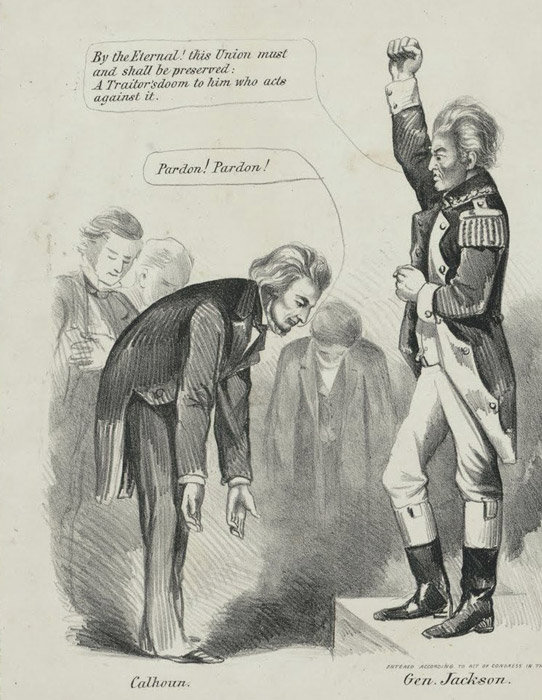
1832 illustration of Jackson arguing with John C. Calhoun that ‘this Union must and shall be preserved’.
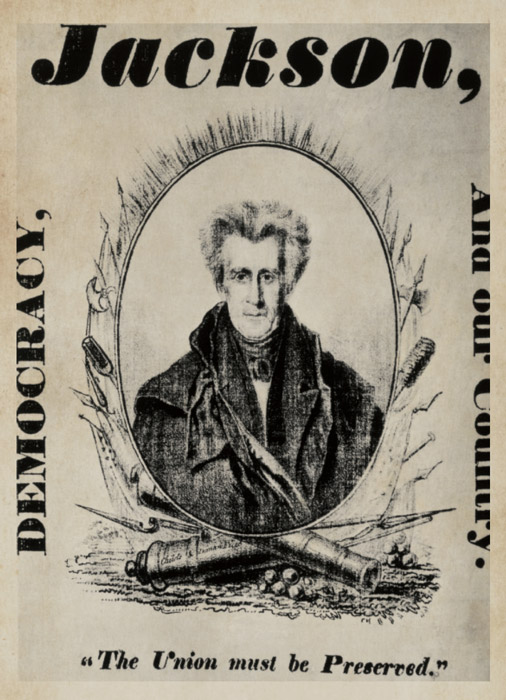
1832 campaign poster. Courtesy Everett Collection Historical / Alamy Stock Photo.
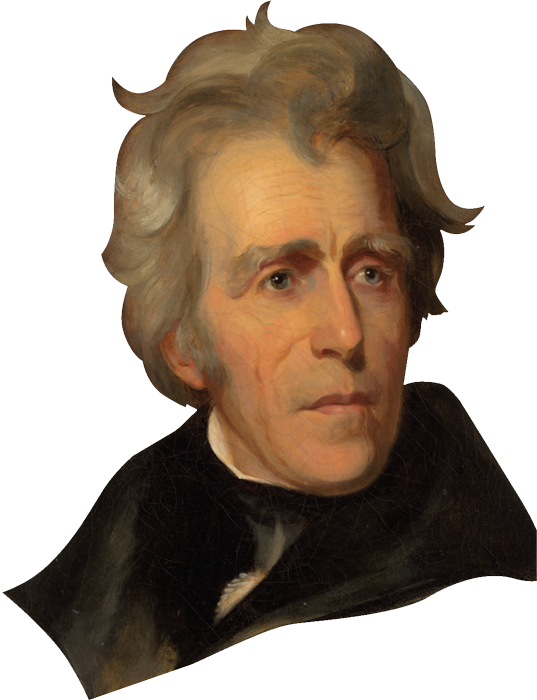
Jackson portrait by Thomas Sully,
Jackson’s Presbyterian Convictions
ANDREW JACKSON had not been a particularly religious man, but on Sunday July 15, 1838 he officially joined the Presbyterian Church. His mother Elizabeth, who had ambitions of him becoming a Presbyterian minister, and wife Rachel, had been devoted members. He promised Rachel he would join but postponed a decision because he felt that as a politician, a public display of his religion might be regarded as “hypocritical”.
1838: Hermitage Presbyterian Church
Now retired, Jackson consulted the Rev James Smith, who ministered at The Hermitage Presbyterian Church, which had been built for Rachel in 1813. Jackson identified with the Presbyterian Church more than any other denomination. During the July 15, 1838 service, he rose in the pew to announce that he wanted to join the church and he further declared belief in its doctrine. Growing up in the Carolinas, he had learned the basics of religion and Christianity. He studied the Bible and the Catechisms and listened attentively to Presbyterian ministers he came in contact with. During his Presidency, he often expressed feelings of a dependence on God.
Now retired, Jackson consulted the Rev James Smith, who ministered at The Hermitage Presbyterian Church, which had been built for Rachel in 1813. Jackson identified with the Presbyterian Church more than any other denomination. During the July 15, 1838 service, he rose in the pew to announce that he wanted to join the church and he further declared belief in its doctrine. Growing up in the Carolinas, he had learned the basics of religion and Christianity. He studied the Bible and the Catechisms and listened attentively to Presbyterian ministers he came in contact with. During his Presidency, he often expressed feelings of a dependence on God.
1843: Rev James Gallagher
His faith was experienced by Tennessee Presbyterian Rev James Gallagher during a pastoral visit to the ageing president at his Hermitage home in 1843. The Rev Gallagher recalled, “The old hero was very frail, and he had the appearance of extreme old age: but he was reposing with calmness and confidence on the promise and covenant of God. He had been a member of the church for several years.” Jackson quoted the words of Rachel’s favourite hymn –
‘How firm a foundation, ye saints of the Lord,
Is laid for your faith in His excellent word!
What more can He say than to you He hath said,
To you who for refuge to Jesus have fled?’
His faith was experienced by Tennessee Presbyterian Rev James Gallagher during a pastoral visit to the ageing president at his Hermitage home in 1843. The Rev Gallagher recalled, “The old hero was very frail, and he had the appearance of extreme old age: but he was reposing with calmness and confidence on the promise and covenant of God. He had been a member of the church for several years.” Jackson quoted the words of Rachel’s favourite hymn –
‘How firm a foundation, ye saints of the Lord,
Is laid for your faith in His excellent word!
What more can He say than to you He hath said,
To you who for refuge to Jesus have fled?’
Death and Funeral
Andrew Jackson died of chronic tuberculosis on June 8, 1845, aged 78. His final words were: “Oh do not cry. Be good children and we shall all meet in heaven”. Two days later, thousands of people gathered on the lawn in front of The Hermitage mansion to pay their last respects and listen to a eulogy as Andrew was laid to rest alongside his late wife Rachel.
Andrew Jackson died of chronic tuberculosis on June 8, 1845, aged 78. His final words were: “Oh do not cry. Be good children and we shall all meet in heaven”. Two days later, thousands of people gathered on the lawn in front of The Hermitage mansion to pay their last respects and listen to a eulogy as Andrew was laid to rest alongside his late wife Rachel.
Memorial Ribbons
Following his death, small silk memorial ribbons imprinted with a likeness of Andrew Jackson were distributed across the nation. Public ceremonies in cities and towns marked his passing. In his last will and testament, dated June 7th, 1843 he left The Hermitage estate to his adopted son Andrew Jackson Jnr.
“I bequeath my body to the dust whence it came and my soul to God who gave it, hoping for a happy immortality through the atoning merits of my Lord Jesus Christ, the Saviour of the world. My desire is that my body be buried by the side of my dear departed wife, in the garden at The Hermitage, in the vault prepared in the garden, and all my expenses paid by my executor hereafter named”.
Andrew Jackson’s Last Will and Testament
Following his death, small silk memorial ribbons imprinted with a likeness of Andrew Jackson were distributed across the nation. Public ceremonies in cities and towns marked his passing. In his last will and testament, dated June 7th, 1843 he left The Hermitage estate to his adopted son Andrew Jackson Jnr.
“I bequeath my body to the dust whence it came and my soul to God who gave it, hoping for a happy immortality through the atoning merits of my Lord Jesus Christ, the Saviour of the world. My desire is that my body be buried by the side of my dear departed wife, in the garden at The Hermitage, in the vault prepared in the garden, and all my expenses paid by my executor hereafter named”.
Andrew Jackson’s Last Will and Testament
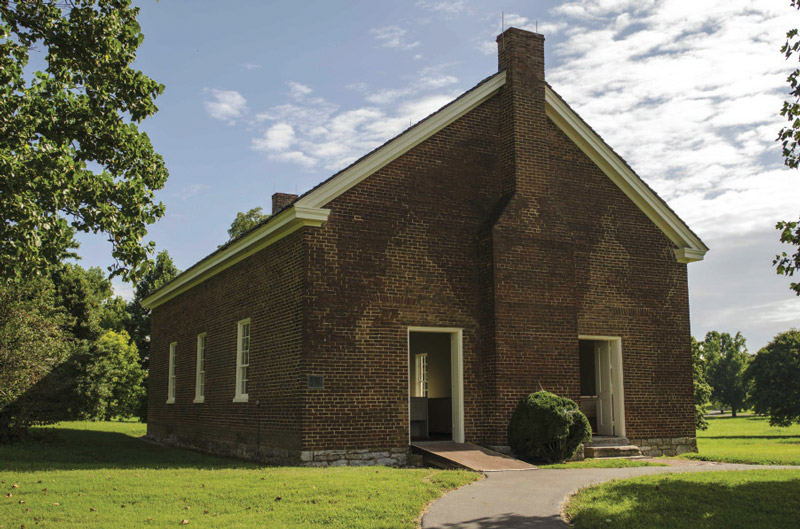
The Hermitage Presbyterian Church was first built in 1824; restored in 1965 following a fire.
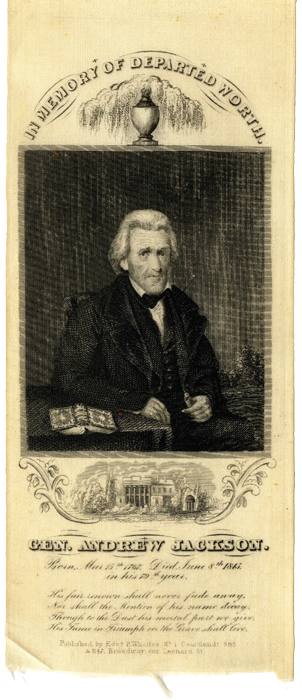
Silk memorial ribbon
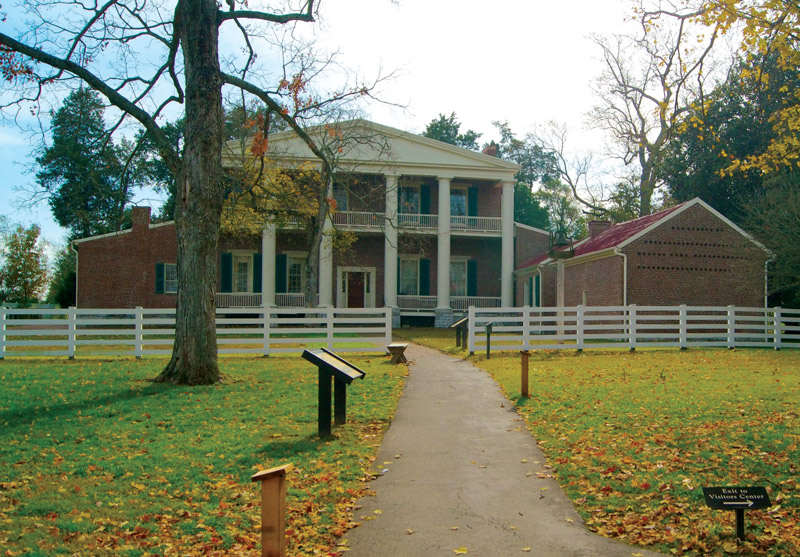
The Hermitage, the Jackson family home, Nashville, Tennessee.
Andrew Jackson’s Legacy
ANDREW JACKSON, born in the humble surroundings of a log cabin in the Waxhaw Scotch-Irish community in the Carolina backcountry on March 15, 1767, was the first common man to rise to the American Presidency. He is also the nearest thing to an Ulster-born United States President, his birth coming just 21 months after his parents Andrew and Elizabeth Jackson left Carrickfergus in Co Antrim for America.
‘Jacksonian Democracy’
The two-party system of Democrats and Republicans is the direct result of Jackson’s decision first to appeal directly to ordinary citizens over the heads of the traditional political class; and then to harness his popularity and cast it into a popular political movement which became the Democratic Party. The ascendancy of ‘Jacksonian Democracy’ is seen by historians and biographers of Andrew Jackson as his greatest achievement. In his two terms as president (1829–33 and 1833–37), after being unsuccessful in the 1824 election, Andrew Jackson made the United States a genuine democracy, governed by and for the people.
The two-party system of Democrats and Republicans is the direct result of Jackson’s decision first to appeal directly to ordinary citizens over the heads of the traditional political class; and then to harness his popularity and cast it into a popular political movement which became the Democratic Party. The ascendancy of ‘Jacksonian Democracy’ is seen by historians and biographers of Andrew Jackson as his greatest achievement. In his two terms as president (1829–33 and 1833–37), after being unsuccessful in the 1824 election, Andrew Jackson made the United States a genuine democracy, governed by and for the people.
Places and Monuments
Places throughout the United States bear the name of Andrew Jackson. The best known is the city of Jackson, which is the State Capitol of Mississippi, but there are no fewer than twenty counties, one parish and at least twelve other settlements around America called Jackson. His nickname, Old Hickory, features in numerous places. There is a Jacksontown in Ohio, while Florida, Illinois and North Carolina each have a Jacksonville. Famous statues in his memory can be seen in Washington DC, Nashville, New Orleans, Jacksonville and Raleigh North Carolina.
Places throughout the United States bear the name of Andrew Jackson. The best known is the city of Jackson, which is the State Capitol of Mississippi, but there are no fewer than twenty counties, one parish and at least twelve other settlements around America called Jackson. His nickname, Old Hickory, features in numerous places. There is a Jacksontown in Ohio, while Florida, Illinois and North Carolina each have a Jacksonville. Famous statues in his memory can be seen in Washington DC, Nashville, New Orleans, Jacksonville and Raleigh North Carolina.
The $20 Bill
The best-known picture of Andrew Jackson is carried in the pockets, purses and wallets of every American, displayed on the twenty-dollar bill since 1928. In 2016, the Obama administration announced that the $20 dollar bill would be redesigned, with Jackson being replaced on the front by former slave and abolitionist Harriet Tubman, with Jackson being featured on the back, alongside the White House. However, this change is not due to take effect until 2020 and there is now some doubt whether the change will take place at all, given the election of President Donald Trump, whose admiration for Andrew Jackson has been widely expressed.
The best-known picture of Andrew Jackson is carried in the pockets, purses and wallets of every American, displayed on the twenty-dollar bill since 1928. In 2016, the Obama administration announced that the $20 dollar bill would be redesigned, with Jackson being replaced on the front by former slave and abolitionist Harriet Tubman, with Jackson being featured on the back, alongside the White House. However, this change is not due to take effect until 2020 and there is now some doubt whether the change will take place at all, given the election of President Donald Trump, whose admiration for Andrew Jackson has been widely expressed.
Trump and Jackson
Throughout the 2016 presidential campaign, Donald Trump positioned himself as a people’s champion, determined to go to Washington DC and “drain the swamp”, making regular reference to Andrew Jackson. Following his inauguration, one of his first actions was to place a portrait of Andrew Jackson in the Oval Office, and a bronze sculpture of Jackson behind the president’s chair. On 15th March 2017, President Trump travelled to The Hermitage to mark the 250th Anniversary of Andrew Jackson’s birth and laid a wreath at his grave, fifty years to the day after LBJ did the same thing.
“Jackson had many faults ... but ... with the exception of Washington and Lincoln, no man has left a deeper mark on American history.”
President Theodore Roosevelt, Visiting The Hermitage, 1907
Throughout the 2016 presidential campaign, Donald Trump positioned himself as a people’s champion, determined to go to Washington DC and “drain the swamp”, making regular reference to Andrew Jackson. Following his inauguration, one of his first actions was to place a portrait of Andrew Jackson in the Oval Office, and a bronze sculpture of Jackson behind the president’s chair. On 15th March 2017, President Trump travelled to The Hermitage to mark the 250th Anniversary of Andrew Jackson’s birth and laid a wreath at his grave, fifty years to the day after LBJ did the same thing.
“Jackson had many faults ... but ... with the exception of Washington and Lincoln, no man has left a deeper mark on American history.”
President Theodore Roosevelt, Visiting The Hermitage, 1907
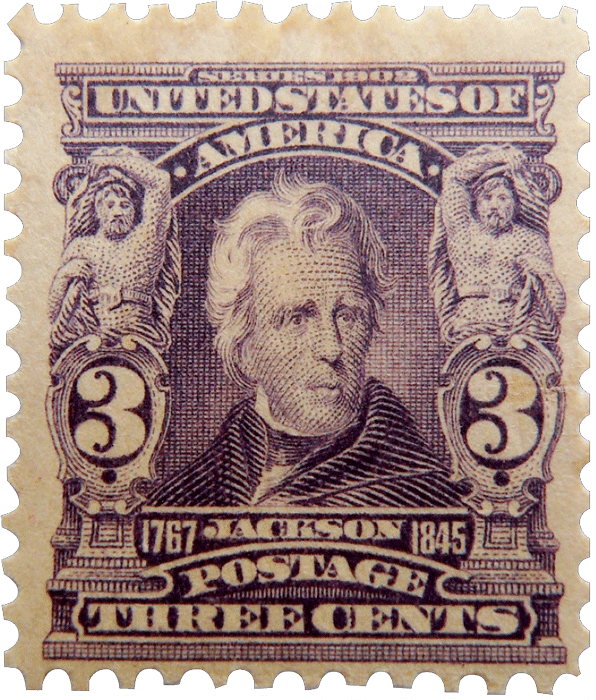
Jackson on the ¢3 postage stamp.
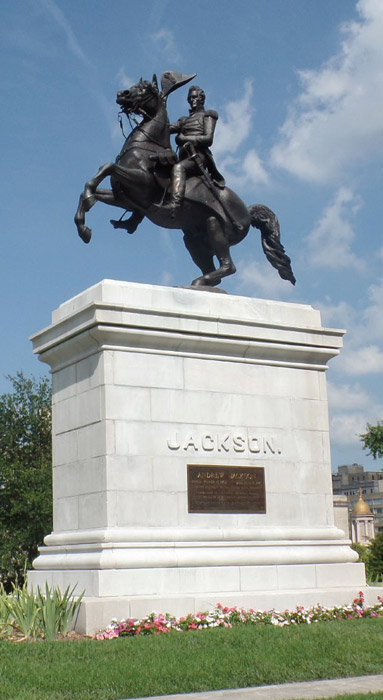
Jackson statue in Nashville, Tennessee.
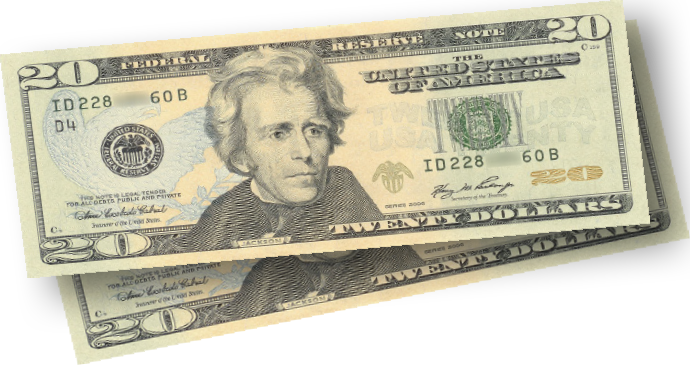
Jackson on the $20 bill

President Donald Trump at the Hermitage, 15th March 2017

